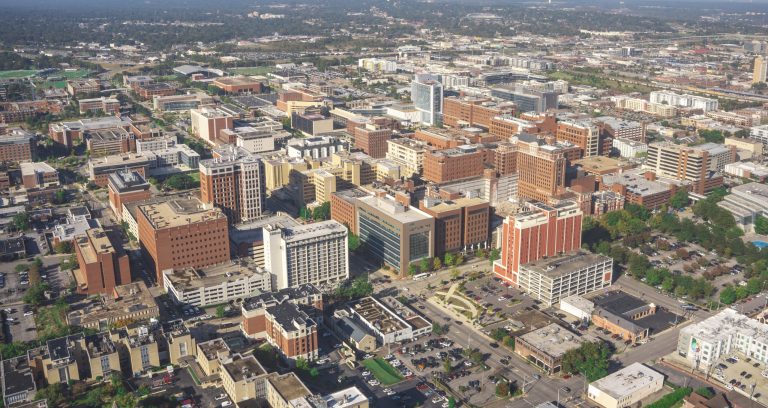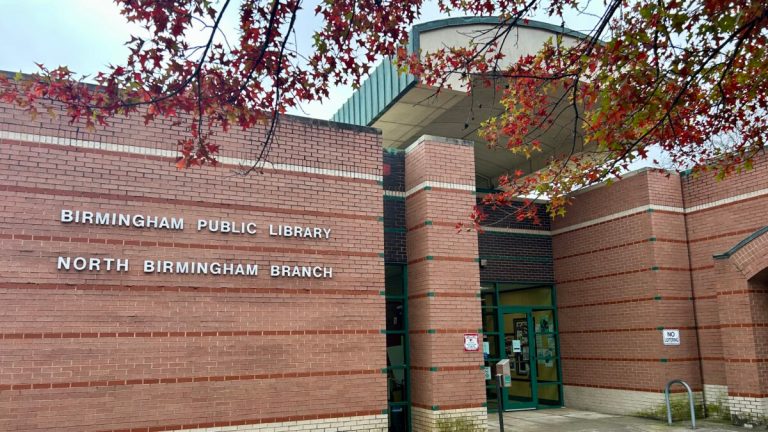“Smoke City” – Birmingham air pollution our past and future
Reading time: 11 minutes
Sponsored

“Smoke City.” In the 1960s, that is what truckers used to call Birmingham when they reached the outskirts of Alabama’s largest city – the self proclaimed “Pittsburgh of the South.”
Before the Clean Air Act was passed in 1970, soot and smog engulfed Birmingham.

Air pollution is part of our DNA.
That all changed significantly in 1971. In Birmingham, a year after the passage of the Clean Air Act, the city’s pollution was so bad, a local federal judge on the behest of the Jefferson County Public Health Department ordered 23 industries shuttered in an effort to protect public health.
Birmingham was ground-zero for the new 1970 Clean Air Act, and what happened here would determine whether the Act would ever be enforced.
Background – Routines
Air pollution in Birmingham had become so routine by the 1960s, that people just carried on and lived with it, despite the devastating impact it was having on their health and wellbeing.
The stories of those routines, which are now decades old, are fast becoming faded memories.
Living with air pollution
According to attorneys at Maynard Cooper & Gale, one of Birmingham’s most respected law firms, their founder, George Fleming Maynard kept a bowl of water in his office to wash his hands before handling documents because of the dirty air that came through his open window.
In the 50s and 60s lawyers and businessmen who walked from their offices to the courthouse or anyone who did business downtown for that matter, would occasionally need to change their starched white shirts when they got back to their offices because of the soot that fell from the region’s steel mills.

Rev. Jayne Pool, an Episcopal priest who grew up on “diaper row” during this era, just off English Village, had vivid memories of Birmingham’s dirty air.
“When I was growing up in our house without AC, my mother had to wipe off the window sills a couple of times a week because the black dust that would accumulate there so quickly. I also remember that she had to (or did) sweep the front porch almost daily for the same reason. As a child, it was how it was and I didn’t think about why there was so much dirt everywhere. As an adult, I sometimes see our window sills and think about how they do not get dirty at all like they used to when I was a kid.”
Our topography, geography and weather
The pre-1970 air polluting steel mills and industries were barely regulated, causing chronic air pollution problems. The make-up of Jones Valley and the mountains surrounding the Magic City exacerbated air pollution. Jefferson County Department of Health’s meteorologist Matt Lacke describes how our natural landscape makes air pollution worse.
“A combination of topography, geography, and weather all contribute to Birmingham’s historical air pollution problem. Birmingham sits within a valley and any pollutant that is emitted within the valley or travels into the valley can get trapped. The hot, sunny, and stagnant summer days that Birmingham typically experiences allow pollutants to build up at the surface with nowhere to go. When an inversion develops in the valley, it can lead to large increases in fine particle pollution or gases that contribute to the formation of ozone at the surface.”
Devastating health impacts – a toxic brew

The combination of heavy industry and our natural landscape created a lethal toxic brew throughout the valley that had a devastating impact on people’s lives. University of Alabama Birmingham’s Dr. Ben Branscomb, a world renowned pulmonologist and one of the area’s first clean air advocates, sounded the alarm at an environmental “teach-in” just before the first Earth Day in April 1970.
At the time, he declared in the Birmingham News, “emphysema is a disease we built for ourselves.”
He provided recent studies that showed an astonishing 27% of all patients in the Birmingham Veterans Administration Hospital had been diagnosed with emphysema.
Video produced by filmmaker Hunter Nichols with interviews with members of GASP and Dr. Branscomb
Speaking to the group of students and faculty at UAB, Branscomb clearly expressed his frustration with the community’s inability to come to grips with the region’s air pollution.
He stated, “I’m a little disturbed to hear of an industry official saying that the high pollution count in Birmingham is due to pollen in the air. If this is true then it is extraordinary the way that pollen (pollution count) always decreases on Sunday afternoons.”
He also criticized the constant call for “more air pollution studies” and decried inaction to regulate and clean up the industries.
“Air pollution has probably been studied here more intensively than in most other American cities. I see patients who come in to me everyday that I feel should not be in this city because of the pollution here.”
Great awakening in Birmingham

The great awakening to Birmingham’s air pollution woes coincided with the birth of the national environmental movement, which took place on Earth Day, April 22nd, 1970. Young professionals and students in Birmingham formed GASP – the Greater Alliance to Stop Pollution. They challenged the status quo and held “Right to Live”events and teach-ins throughout the community culminating before Earth Day.
They were creative and bold. As Cameron Vowell, one of the leaders in the GASP student movement commented, “student activism for environmental causes shook up the local political machinery of the day.”
In 1971, GASP went beyond the benevolent teach-ins and Earth Day events and called for the state to enact the recently passed 1970 federal Clean Air Act, and to their credit the state Clean Air Act which passed in early 1971 by the Alabama Legislature. Despite the passage of the two laws, Governor George Wallace dragged his feet, stonewalling the creation of the new regulatory agency by not appointing members to a state Air Pollution Control Commission. That one action prevented the Commission setting up the agency and establishing enforceable clean air rules.

GASP dramatically caused a stir enlisting the help of the Birmingham Zoo Director, Bob Truet, who allowed members of GASP to occupy one of the primate cages, holding signs that read – “Homo sapiens: the only species known to pollute its own environment and wage war.”
The stage was set – the five days that changed Birmingham
In 2010, Dr. Michael Fleenor, Jefferson County’s Public Health Officer for nearly two decades, gave a speech to the Jefferson Medical Society that outlined the fateful 5 days in November 1971 that changed how Birmingham and the nation addressed air pollution.
In the presentation, he described how the “stage was set” – the passage of the new federal and state clean air acts, the state’s (governor) unwillingness to enact the new laws, the public health community’s concerns about the damage air pollution was doing to people, and the new environmental movement led by young professionals and students.
November 15- 21, 1971

And then there was the week in November 1971 when the “toxic brew” became lethal. Here is how Fleenor recounted that week.
“The week of November 15, 1971 brought matters to a head. The entire Southeast was under a high pressure dome that birthed a thermal inversion in Jones Valley, the cradle of Birmingham. Birmingham was experiencing “Indian Summer” as temperatures hovered in the low to mid 80s. Steel plants were operating at full throttle and churning out smoke that due to this thermal “lid” had no place to go. Birmingham was literally being chocked in a layer of smog so thick that the cupola on Jefferson Tower could hardly be seen from Vulcan. The air was literally becoming too toxic to breathe.”
Ironically, on the day the public health emergency began, November 15th, Governor Wallace, who had held up the appointments for months constituted the Clean Air Commission. Unfortunately because of the delay, the Health Department did not have any enforceable regulations to compel the major polluters to reduce emissions.
Something had to be done
The forecast was dire. The Jefferson County Health Department first asked all the 23 major emitters of air pollution in Birmingham to voluntarily reduce their emissions. According to Fleenor’s account many of the smaller companies complied in some fashion, while the largest emitters who contributed 70% of the total air pollution “for all practical purposes” ignored the request.
With conditions worsening and air pollution monitors nearing the highest emergency threshold the Jefferson County Health Department recognized they were not going to compel the large industries to voluntarily reduce their emissions. After consulting with the State Health Department and the Attorney General, the Jefferson Health Department asked the EPA and the Justice Department to step in. And as Fleenor described it, “they stepped in BIG.”

EPA steps in
For the first time in its early history EPA made the decision to compel industry to employ efforts to reduce air pollution. They prepared a 10 day temporary restraining order compelling all 23 industries to greatly reduce their emissions to protect the public. The order was signed by Federal District Judge Sam Pointer.
Immediate legal wrangling ensued, but two days after the order was issued the weather improved and the court order for industry to comply was vacated.
Congress held a subsequent hearing in Birmingham on the issue. Amidst vocal complaints from the industries and business community about aggressive federal overreach, Dr. George Hardy, the Jefferson County Public Health Officer, infamously declared:
“If you are saying that we should be counting bodies before we do something, I disagree!”
From soot to fine particles – harmful and deadly

Today, 46 years later, Birmingham is no longer called “Smoke City.” Attorneys don’t have to change shirts after they walk outdoors and in most cases, you don’t need to sweep soot and dust off the porch everyday.
Birmingham’s air pollution problems of yesteryear, clouds of orange pollutants from belching steel mills have been replaced by fine particles and ozone pollution which are virtually invisible to the naked eye but just as harmful and deadly. It’s deceptive and it breeds complacency.
We should never forget, what it was like before Clean Air legislation was enacted. And thanks to brave public health officials, physicians, young professionals, students and those folks who simply cared – here in Birmingham, countless loved ones lives have been saved.
Birmingham’s DNA
Air pollution continues to be a part of Birmingham’s DNA. In the coming weeks, we will examine why the fight for clean air is important now more than ever.

 13148 views
13148 views

